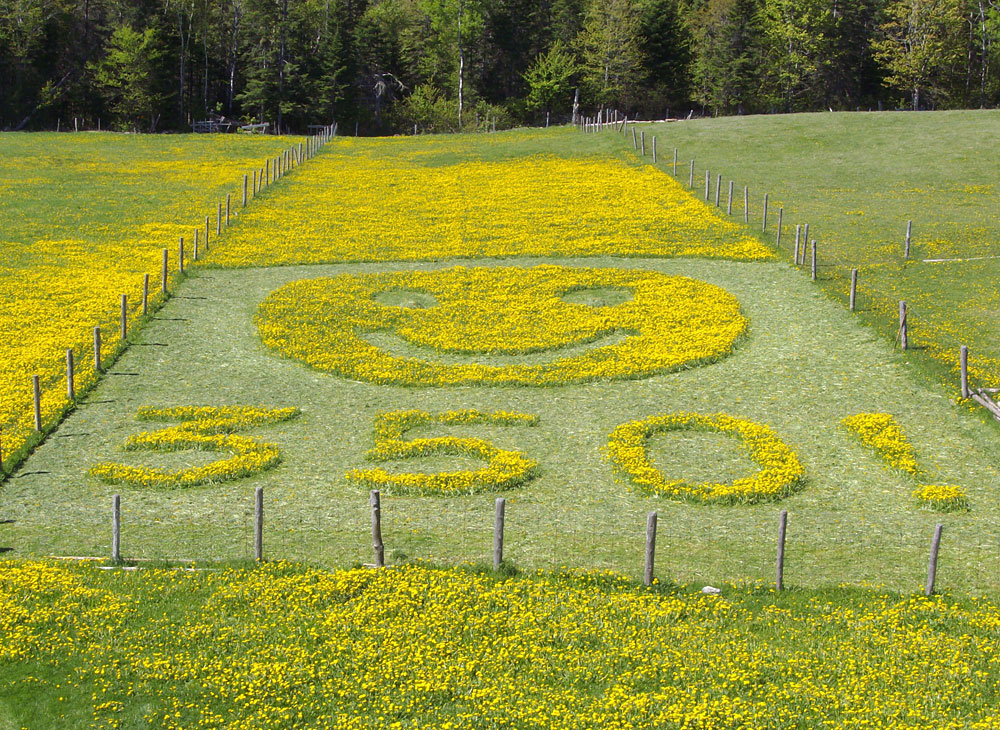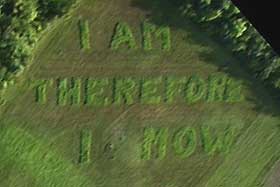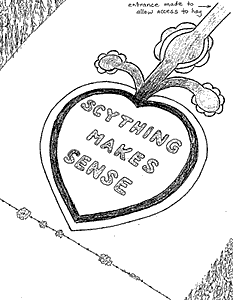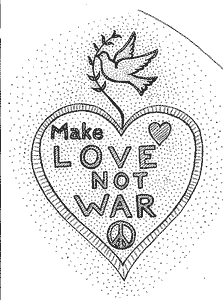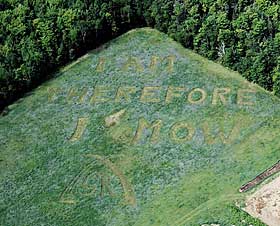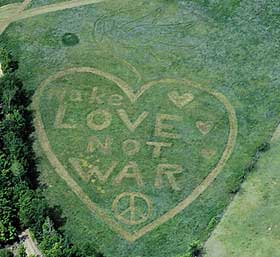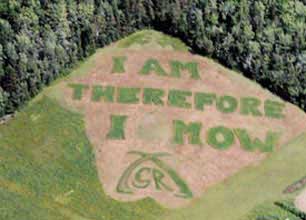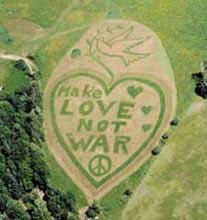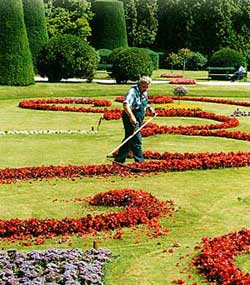
Site Contents
About Us
Contact Us
Events
Products
Scythe Buyers' Guide
Technical/
Instructional
Updates
Video
Home
The Grinning Reapers' Artwork
 With a little experience, a scythe can become the mower's "paintbrush" - a tool for creating designs as small as a backyard flower garden or as large as a mountainside meadow. They may be purely decorative or meant to convey an idea. The message that all the signs in this section carry is the result of recreation and "useful labour" combined -- because we always have fun mowing and the designs are, after all, eventually eaten up as hay by our animals. Alternately, the animal feed can be thought of as the fringe benefit received in the process of expressing one's sentiments and convictions.
For those who may like to play around with sign- and hand-haymaking more than is perhaps necessary, here is our method: Step 1. Step 2. Except for our very first ("Scything Makes Sense"), we prepared the signs before the season's growth began by outlining the design lightly with partially composted manure. (Below is the view of the first day of making the Medicine Wheel -- shot from a nearby tree.) This provides an effective visual guide for the first session of cutting (when the grass is about 6" high). Later -- due to the added fertility and thereby stimulated growth- the sign will also "help to create itself". As an example, the local organizers of the First International Scythe Symposium and Festival in Austria did just this; they fed the grass outlining the design some nitrogen before growth began. They did not find time for my suggested follow-up steps, but by early July the outline of the logo -- because it was on a steep mountainside -- could be seen from a distance. Given the fact that this was a scythe event, the process, in a way, was a fake. Nevertheless, it accomplished something, and perhaps for some 350 concept enthusiasts, this may be sufficient substitute for hand mowing. Not for me though -- and thus I continue with outlining the "proper" process. The grass cut during the first mowing, because it is still so short and young, can be left right there (instead of being removed). But it should be spread evenly rather than left in a windrow because it will then more quickly settle down and not interfere with the second mowing. By the second trip over, all stakes/strings have been removed since the younger, greener growth already defines the pattern. Many more people could effectively help at this stage than during the first one. For us on the farm, this cut is an actual hay making step -- everything mown is dried and stored away as animal feed. Step 3. At this stage a scythe-use course could be held and a great number (if the sign is large) of complete beginners effectively participate. The distinction between the tall blossoming stand and the shorter, greener design is easy to see. The greenhorns should be instructed to stop within a few inches (or a foot) of the line and the more competent of the mowers can then refine it. This is what we did during our 2006 event here - the Medicine Wheel was mown by almost 50 people, a portion of whom had barely mowed before that week. The material, of course, should be evenly spread as soon as it is cut and later made into hay. One last step to help the sign be easily found next spring: Just before the first snow we cut the leftover scant growth from the narrow lines defining the design. The many heavy frosts it had by then received make it dry enough so that in a few hours of a sunny afternoon it can be put on racks. PhotosThe central fire pit of the Medicine Wheel sign has functioned for small gathering of friends during Solstices and Equinoxes, or just any full moon to sit by. Well, yes (in case some of the CO2 purists wonder) - at this point in time we still consider the occasional ceremonial bonfire a "justifiable" contribution to climate change...
This sign underscores the previous one (or is it the other way around?) In any case, we made it two years earlier, in the summer of 2001, as a kind of inauguration of our commitment to carry this message further afield and connect with scythe enthusiasts in Europe. We found Adolf Staufer in Molln, Austria, and the first concrete plans for our Symposium/Festival were made. The birth of this website was a natural follow-up. "Scything Makes Sense" simply expresses the core of this Network's efforts -- though it would not make sense to oil companies or lawn mower manufacturers. While relatively benign, it nevertheless defies their point of view... Rebellious mowers with strong opinions can "write" protesting messages which, unlike the graffiti within a city, cannot be painted over by the corporate janitors -- or attacked with billy clubs for "disturbing the peace" during a world trade convention. Will it help? Of course. As Buddhists and nuclear physicists alike understand, "even one beat of a mosquito's wing affects the Universe". We are all also now under Big Brother's watchful eye... The sign below was inspired by the Bush Administration's approach to bringing peace to the people of the earth, because the old '60s slogan is still pertinent. As Willie Nelson put it in his (Christmas 2003) song: "There's so many things going on in the world
A little note on the phenomenon of so-called "crop circles" and similar mysterious occurrences.
Until some real scientists seriously investigate the phenomenon, we'd appreciate hearing from anyone who might have some useful/fact-based ideas... After the design itself was mowed for the second time since the grass started to grow this year, Bob West of Bath, N.B. was kind enough to fly his little plane over the fields and take the photos below. The dove (being on a differently sloped part of the meadow than the heart) is barely visible. It will all look better next time when we mow and make into hay all the areas in between the design.
July 10, 2004 -- The clarity of the photos is now improving. These shots were taken once we mowed the areas between the letters for the first time this season. The brownish background is the spread-out grass which received several showers while waiting for the plane. The designs cover approximately 3 acres each.
New domain registration comfortable . Try business website hosting at this site . Cater Orange County web design and make your customers feel like a navigator in your website.
| |||||||||||||||||
